|
ADDENDUM
As of 11:05 Tuesday, July 26, 1983, the list of member banks holding
Federal Reserve Bank of New York stock includes twenty-seven New
York City banks. Listed below are the number of shares held by ten
of these banks, amounting to 66% of the total outstanding number of
shares, namely 7,005,700:
|
|
Shares
|
Percent
|
|
Bankers Trust Company
|
438,831
|
( 6%)
|
|
Bank of New York
|
141,482
|
( 2%)
|
|
Chase Manhattan Bank
|
1,011,862
|
(14%)
|
|
Chemical Bank
|
544,962
|
( 8%)
|
|
Citibank
|
1,090,813
|
(15%)
|
|
European American Bank & Trust
|
127,800
|
( 2%)
|
|
J. Henry Schroder Bank & Trust
|
37,493
|
(
.5%)
|
|
Manufacturers Hanover
|
509,852
|
(
7%)
|
|
Morgan Guaranty Trust
|
655,443
|
( 9%)
|
|
National Bank of North America
|
105,600
|
( 2%)
|
The tremendous number of shares held today as against the original
purchases in 1914 is brought about by Section 5 of the original
Federal Reserve Act which called for a member bank to buy and hold
stock in the district Federal Reserve Bank equal to 6% of its
capital and surplus.
Currently, shares held by five of the above named banks comprise 53%
of the total Federal Reserve Bank of New York stock. An examination
of the major stockholders of the New York City banks shows clearly
that a few families, related by blood marriage, or business
interests, still control the New York City banks which, in turn,
hold the controlling stock of the Federal Reserve Bank of New York.
It is notable that three of the banks holding Federal Reserve Bank
of New York stock, in the amount of 270,893 shares, are
subsidiaries
of foreign banks.
-
J. Henry Schroder Bank and Trust is listed by
Standard and Poors as a subsidiary of Schroders Ltd. of London.
-
The
National Bank of North America is a subsidiary of the National
Westminster Bank, one of London’s "Big Five".
-
European American Bank
is a subsidiary of the European American Bank, Bahamas, LTD.
It is
interesting to note that the directors of the European American Bank
& Trust include:
-
Milton F. Rosenthal, president and Chief Operating
Officer of the international gold company,
Engelhard Minerals and Chemical;
-
Hamilton F. Potter, a partner in
Sullivan and Cromwell (J. Henry Schroder Bank & Trust attorneys);
-
Edward H. Tuck, partner of Shearman and Sterling (Citibank’s
attorneys);
-
F.H. Ulrich and Hans Liebkutsch, managing directors of
the giant Midland Bank of London, one of the "Big Five"; and
-
Roger Alloo, Paul-Emmanuel Janssen, and Maurice Laure of the Societe
Generale de Banque (Brussels, Belgium).
[See Chart III]
This information, derived from the latest issue of the tabulation
available from the Board of Governors, Federal Reserve System, is
cited as current evidence which indicates that the controlling stock
in the Federal Reserve Bank of New York, which sets the rate and
scale of operations for the entire Federal Reserve System is heavily
influenced by banks directly controlled by "The London Connection",
that is, the Rothschild-controlled Bank of England. [See Chart I]
Go Back
APPENDIX I
-
E.C. Knuth, in The Empire of the City, priv. printed, 1946, p. 27,
refers to "the Bank of England, the full partner of the American
Administration in the conduct of the financial affairs of all the
world" and cites the Encyclopaedia Americana, 1943 edition.
-
Barron cites Lord Swaythling, (April 8, 1923), "Lord Swaythling
said, ‘Exchange can only be run from London. This is the center in
Exchange.’" (They Told Barron, by Clarence W. Barron, founder of
Baron’s Weekly, Harpers, New York, 1930, p. 27.)
-
Exchange, in the international financial world, means the
transactions in money or securities, or simply, the "exchange" of
the values of these securities. It is necessary that this "exchange"
take place where the values can be established, and this place is
the "City" in London.
-
London was established as the primary center of exchange because of
the "Consols" of the Bank of England, bonds which could never be
redeemed, but which paid a stable rate of return. Henry Clews
writes, in The Wall Street View, Silver Burdett Co. 1900, p. 255,
-
By ostentatiously
"dumping" "Consols" on the London Exchange after the
Battle of
Waterloo, in a pretended panic, Nathan Meyer Rothschild then
secretly bought up the Consols sold in the panic by other holders at
a low rate, and became the largest holder of Consols, and thus won
control of the Bank of England in 1815.
12% Dividends
Although a Labor government nationalized the Bank of England in
1946, The Great Soviet Encyclopaedia points out (vol. I, p. 490c)
that the Bank of England continues to pay 12% dividends per annum,
just as it had done prior to the nationalization.
The "Governor" is
appointed by the government, in a situation similar to that in the
United States, where the Governors of the Federal Reserve System are
appointed by the President. However, as is pointed out in the
Encyclopaedia Americana v. 13, p. 272,
"In practice, the governors
of the Bank of England have not hesitated to criticize and bring
pressure on the government in public."
Bank Rate
The interest rate set by the Bank of England is known as "the Bank
rate", and it is a controlling factor in interest rates throughout
the world,
although rates in other countries may be higher or lower than this
"Bank rate". The Bank of England manages the government debt, and is
called upon to arbitrate in political affairs. It served as the
intermediary with the Iran revolutionaries in negotiating for the
return of the American hostages--a recent example.
We should not be surprised that the present Governor of the Bank of
England, Sir Gordon Richardson is a prominent international
financial figure, who appears elsewhere in these pages because of
his connection with the J. Henry Schroder Wagg in London from 1962
to 1972, when he became Governor of the Bank of England. He was also
director of J. Henry Schroder Co., New York, and Schroder Banking
Corp., New York. He also serves as director of Rolls Royce and
Lloyd’s Bank. Although he resides in London, he maintains a home in
New York, and is listed in the current Manhattan directory simply as
"G. Richardson, 45 Sutton Place S.", although a prior listing showed
him at 4 Sutton Place. Sutton Place was developed as a fashionable
address for the international set by Bessie Marbury, whom we earlier
cited for her connection with the Morgan family and the Roosevelts.
The present directors of the Bank of England (1982) include
Leopold
de Rothschild of N.M. Rothschild & Sons, Sir Robert Clark, chairman
of Hill Samuel Bank, the most influential bank after Rothschilds, John Clay, of Hambros Bank, and David Scholey, of Warburg Bank, and
joint chairman of S.C. Warburg Co.
Anthony Sampson writes, in "The Changing Anatomy of Britain", Random
House, New York, 1982, p. 279,
"The more cosmopolitan banks with
foreign experts and directors, such as Warburgs, Montagus,
Rothschilds and Kleinworts, had also discovered a huge new source of
profits in the market for Eurodollars which began in the late
fifties and multiplied through the 60s . . . British bankers
themselves controlled relatively small funds, but they knew how to
make money out of other people’s money."
The Eurodollar market, a new development in "created money" is
monopolized by the above firms.
Eurodollar Empire
"Today, together with allies on the island of
Manhattan (Britain’s
most important piece of real estate), the British Empire controls
the entire $1.5 trillion Eurodollar financial market, another
$300-$500 billion in the Cayman Islands, Bahamas, and $50-$100
billion in the Hong-Kong Singapore "Asia-dollar market"...
Consider the $1.5 trillion Eurodollar market an "outlaw" market in
the U.S. dollars over which this nation has no control. Here control
and profits are overwhelmingly in the hands of London banks, who set
the terms of lending and the interest rate on this mass of American
dollars in relation to the London Interbank Borrowing
Rate (LIBOR)... U.S. banks like Citibank (New York City), on
whose board of directors sits the powerful British financier, Lord Aldington, collaborate openly in this market. At the same time,
British banks including the known central bank for the world’s drug
trade, the Hong Kong and Shanghai Bank, pour into America to devour
U.S. banks.
In 1978 the Hongshang (Ed.--Hongkong and Shanghai Bank)
took over New York’s Marine Midland Bank, the state’s 11th largest
commercial bank... The British also control the creation of
American dollars. While Federal Reserve Board Chairman Paul Volcker
tightens credit against the domestic economy, British-controlled
banks in the Cayman Islands (such as the European American
Bank--Ed.) a British possession 200 miles off Florida, and in the
Bermudas and a dozen other "free banking" computer terminals create
hundreds of billions of American dollars. How is this done? There
are no reserve ratios or other restrictions on the creation of
dollar-denominated credits in the Empire’s "free enterprise"
banking. A $1 million bona fide credit coming from the United States
can be turned into $20 to $100 million in dollar-denominated credits
as it passes through the British system without reserve ratios." *
* Harpers Magazine, Feb. 1980
Not only the financial power, but also the legal power, has remained
seated in Britain. The Washington Post commented on June 18, 1983
that after the American Revolution, all the old laws remained in
effect in the new United States: Some of these laws of "English
common law" dated back to 1278, long before America was discovered.
This enormous financial power of "the City" is revealed in many
areas. Dean Acheson states, in "Present at the Creation", 1969, W.W.
Norton, New York, p. 779,
"We stayed at the embassy residence, the
old J.P. Morgan mansion, 14 Prince’s Gate, facing Hyde Park."
How
many Americans are aware that the U.S. Embassy residence in London
is the J.P. Morgan home, or that Dean Acheson, a former
Morgan
employee, described himself as Secretary of State on p. 505,
"My own
attitude had long been, and was known to have been, pro-British."
No
one commented on an American Secretary of State’s open bias in favor
of England.
The Federal Reserve "created" money is not used only for financial
matters; this money is also used to maintain the bankers’ control of
every aspect of political, economic and social life. It is used to
bankroll the enormous expenditures of political candidates, the
swollen budgets of universities, the huge outlays required to start
newspapers or magazines, and a vast array of foundations,
"think-tanks" and other instruments of mind control.
Psychological Warfare
Few Americans know that almost every development in psychology in
the United States in the past sixty-five years has been directed by
the Bureau of Psychological Warfare of the British Army. A short
time ago,
the present writer learned a new name,
The Tavistock Institute of
London, also known as the Tavistock Institute of Human Relations.
"Human relations" covers every aspect of human behavior, and it is
the modest goal of the Tavistock Institute to obtain and
exercise
control over every aspect of human behavior of American citizens.
Because of the intensive artillery barrages of World War I, many
soldiers were permanently impaired by shell shock. In 1921, the
Marquees of Tavistock, 11th Duke of Bedford, gave a building to a
group which planned to conduct rehabilitation programs for shell
shocked British soldiers. The group took the name of "Tavistock
Institute" after its benefactor. The General Staff of the British
Army decided it was crucial that they determine the breaking point
of the soldier under combat conditions. The Tavistock Institute was
taken over by Sir John Rawlings Reese, head of the British Army
Psychological Warfare Bureau.
A cadre of highly trained specialists
in psychological warfare was built up in total secrecy. In fifty
years, the name "Tavistock Institute’ appears only twice in the
Index of the New York Times, yet this group, according to LaRouche
and other authorities, organized and trained the entire staffs of
the Office of Strategic Services (OSS), the Strategic Bombing
Survey, Supreme Headquarters of the Allied Expeditionary Forces, and
other key American military groups during World War II. During World
War II, the Tavistock Institute combined with the medical sciences
division of the Rockefeller Foundation for esoteric experiments with
mind-altering drugs.
The present drug culture of the United States
is traced in its entirety to this Institute, which supervised the
Central Intelligence Agency’s training programs. The "LSD counter
culture" originated when Sandoz A.G., a Swiss pharmaceutical house
owned by S.G. Warburg & Co., developed a new drug from lysergic
acid, called LSD.
James Paul Warburg (son of Paul Warburg who had
written the Federal Reserve Act in 1910), financed a subsidiary of
the Tavistock Institute in the United States called the Institute
for Policy Studies, whose director, Marcus Raskin, was appointed to
the National Security Council. James Paul Warburg set up a CIA
program to experiment with LSD on CIA agents, some of whom later
committed suicide. This program,
MK-Ultra, supervised by Dr.
Gottlieb, resulted in huge lawsuits against the United States
Government by the families of the victims.
The Institute for Policy Studies set up a campus subsidiary,
Students for Democratic Society (SDS), devoted to drugs and
revolution. Rather than finance SDS himself, Warburg
used CIA funds,
some twenty million dollars, to promote the campus riots of the
1960s.
The English Tavistock Institute has not restricted its activities to
left-wing groups, but has also directed the programs of such
supposedly "conservative" American think tanks as the Herbert Hoover
Institute at Stanford University, Heritage Foundation, Wharton,
Hudson, Massachusetts Institute of Technology, and Rand. The
"sensitivity training" and "sexual encounter" programs of the most radical California
groups such as
Esalen Institute and its many imitators were all
developed and implemented by Tavistock Institute psychologists.
One of the rare items concerning the Tavistock Institute appears in
Business Week, Oct. 26, 1963, with a photograph of its building in
the most expensive medical offices area of London. The story
mentions "the Freudian bias" of the Institute, and comments that it
is amply financed by British blue-chip corporations, including
Unilever, British Petroleum, and Baldwin Steel. According to
Business Week, the psychological testing programs and group
relations training programs of the Institute were implemented in the
United States by the University of Michigan and the University of
California, which are hotbeds of radicalism and the drug network.
It was the Marquees of Tavistock, 12th Duke of Bedford, whom
Rudolf
Hess flew to England to contact about ending World War II. Tavistock
was said to be worth $40 million in 1942. In 1945, his wife
committed suicide by taking an overdose of pills.
Go Back
BIOGRAPHIES
 NELSON ALDRICH (1841-1915)
(image right) NELSON ALDRICH (1841-1915)
(image right)
Senator from Rhode Island; head of National Monetary Commission; his
daughter Abby Aldrich married
John D. Rockefeller, Jr.; he became
the grandfather of his namesake. Nelson Aldrich Rockefeller, as well
as the present David Rockefeller and Laurence Rockefeller.
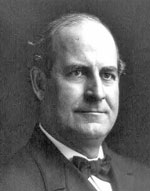 WILLIAM JENNINGS BRYAN (1860-1925)
(image right) WILLIAM JENNINGS BRYAN (1860-1925)
(image right)
Woodrow Wilson’s Secretary of State, three times losing presidential
candidate of the Democratic Party, in 1896, 1900, and 1908, and head
of the Democratic Party.
 ALFRED OWEN CROZIER (1863-1939)
(image right) ALFRED OWEN CROZIER (1863-1939)
(image right)
A prominent attorney in Grand Rapids, Cincinnati, and New York,
Crozier wrote eight books on legal and monetary problems, focusing
on his opposition to the supplanting of Constitutional money by the
corporation currency printed by private firms for their profit.
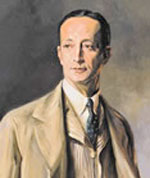 CLARENCE DILLON (1882-1979)
(image right) CLARENCE DILLON (1882-1979)
(image right)
Born in San Antonio, Texas, son of Samuel Dillon and Bertha
Lapowitz. Harvard, 1905. Married Anne Douglass of Milwaukee. His
son, C. Douglas Dillon (later Secretary of the Treasury, 1961-65)
was born in Geneva, Switzerland in 1909 while they were abroad.
Dillon met William A. Read, founder of the Wall Street bond broker
William A. Read and Company, through introduction by Harvard
classmate William A. Phillips in 1912 and Dillon joined Read’s
Chicago office in that year. He moved to New York in 1914. Read died
in 1916, and Dillon bought a majority interest in the firm. During
World War 1, Bernard Baruch, chairman of the War Industries Board,
(known as the Czar of American industry) asked Dillon to be
assistant chairman of the War Industries Board. In 1920, William A.
Read & Company name was changed to Dillon, Read & Company. Dillon
was director of American Foreign Securities Corporation, which he
had set up in 1915 to finance the French Government’s purchases of
munitions in the United States. His righthand man at Dillon Read,
James Forrestal, became Secretary of the Navy, later Secretary of
Defense, and died under mysterious circumstances at a Federal
hospital. In 1957, Fortune Magazine listed Dillon as one of the
richest men in the United States, with a fortune then estimated to
be from $150 to $200 million.
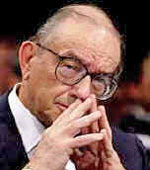 ALAN GREENSPAN (1926- )
(image right) ALAN GREENSPAN (1926- )
(image right)
Appointed by President Reagan to succeed Paul Volcker as Chairman of
the Board of Governors of the Federal Reserve System in 1987.
Greenspan had succeeded Herbert Stein as chairman of the President’s
Council of Economic
Advisors in 1974. He was the protégé of former chairman of the Board
of Governors, Arthur Burns of Austria (Bernstein). Burns was a
monetarist representing the Rothschild’s Viennese School of
Economics, which manifested its influence in England through the
Royal Colonial Society, a front for
Rothschilds and other English
bankers who stashed their profits from the world drug trade in the
Hong Kong Shanghai Bank. The staff economist for the Royal Colonial
Society was Alfred Marshall, inventor of the monetarist theory, who,
as head of the Oxford Group, became the patron of Wesley Clair
Mitchell, who founded the National Bureau of Economic Research for
the Rockefellers in the United States.
Mitchell, in turn, became the
patron of Arthur Burns and Milton Friedman, whose theories are now
the power techniques of Greenspan at the Federal Reserve Board.
Greenspan is also the protégé of Ayn Rand, a weirdo who interposed
her sexual affairs with guttural commands to be selfish. Rand was
also the patron of CIA propagandist William Buckeley and the
National Review. Greenspan was director of major Wall Street firms
such as J.P. Morgan Co., Morgan Guaranty Trust (the American bank
for the Soviets after the Bolshevik Revolution of 1917), Brookings
Institution, Bowery Savings Bank, the Dreyfus Fund, General Foods,
and Time, Inc. Greenspan’s most impressive achievement was as
chairman of the National Commission on Social Security from
1981-1983. He juggled figures to convince the public that Social
Security was bankrupt, when in fact it had an enormous surplus.
These figures were then used to fasten onto American workers a huge
increase in Social Security withholding tax, which invoked David
Ricardo’s economic dictum of the iron law of wages, that workers
could only be paid a subsistence wage, and any funds beyond that
must be extorted from them forcibly by tax increases. As a partner
of J.P. Morgan Co. since 1977, Greenspan represented the unbroken
line of control of the Federal Reserve System by the firms
represented at the secret meeting on Jekyll Island in 1910, where
Henry P. Davison, righthand man of J.P. Morgan, was a key figure in
the drafting of the Federal Reserve Act.
Within days of taking over
as chairman of the Federal Reserve Board, Greenspan immediately
raised the interest rate on Sept. 4, 1987, the first such increase
in three years of general prosperity, and precipitated the stock
market crash of Oct., 1987, Black Monday, when the Dow Jones average
plunged 508 points. Under Greenspan’s direction, the Federal Reserve
Board has steadily nudged the United States deeper and deeper into
recession, without a word of criticism from the complaisant members
of Congress.
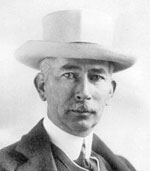 COLONEL EDWARD MANDELL HOUSE (1858-1938)
(image right) COLONEL EDWARD MANDELL HOUSE (1858-1938)
(image right)
Son of a Rothschild agent in Texas. Succeeded in electing five
consecutive governors of Texas; became Woodrow Wilson’s advisor in
1912. Cooperated with Paul Warburg to get the Federal Reserve Act
passed by Congress in 1913.
 ROBERT MARION LAFOLLETTE (1855-1925)
(image right) ROBERT MARION LAFOLLETTE (1855-1925)
(image right)
Served in Senate from Wisconsin 1905-25. Led agrarian reformers in
opposing Eastern bankers and their plans for the Federal Reserve
Act. Ran for President in 1924 on Progressive-Socialist ticket.
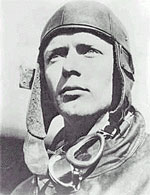 CHARLES AUGUSTUS LINDBERGH, SR. (1860-1924)
(image right) CHARLES AUGUSTUS LINDBERGH, SR. (1860-1924)
(image right)
Congressman from Minnesota (1907-1917) who led the fight against
enactment of the Federal Reserve Act in 1913. He served until 1917
when he resigned to run for governor of Minnesota. He ran a good
campaign despite adverse newspaper attacks led by The New York
Times. His campaign was adversely affected when Federal agents
burned his books, including Why Is Your Country At War? and the
papers and contents of his home office in Little Falls, Minnesota.
LOUIS T. McFADDEN (1876-1936)
Congressman and Chairman of the House Banking and Currency
Committee, 1927-33; courageously opposed the manipulators of the
Federal Reserve System in the 1920’s and the 1930’s. Introduced
bills to impeach Federal Reserve Board of Governors and allied
officials. After three attempts on his life, he died mysteriously.
 JOHN PIERPONT MORGAN (1837-1913)
(image right) JOHN PIERPONT MORGAN (1837-1913)
(image right)
Considered the dominant American financier at the turn of the
century. Who’s Who in 1912 stated he "controls over 50,000 miles of
railroads in the United States." Organized United States Steel
Corporation. Became representative of House of Rothschild through
his father, Junius S. Morgan, who had become London partner of
George Peabody & Company, later Junius S. Morgan Company, a
Rothschild agent. John Pierpont Morgan, Jr. succeeded his father as
head of the Morgan empire.
DAVID MULLINS (1946- )
Appointed Governor of the Federal Reserve Board May 21, 1990, David
Mullins’ term runs to Jan. 31, 1996. He was recently nominated to
serve as Vice Chairman of the Federal Reserve Board, and served as
Assistant Secretary of the Treasury for Domestic Finance 1988-90,
receiving the department’s highest award, the Alexander Hamilton
Award, for his service in such programs as synthetic fuels, federal
finance, Farm Credit Assistance Board, and author of the President’s
Plan for rescuing the savings and loan institutions. He is a distant
cousin of the author, descended from John Mullins, the first
recorded settler in the western area of Virginia, hero of the battle
of King’s Mountain, and recipient of a 200 acre grant of land for
his service in the American Revolution.
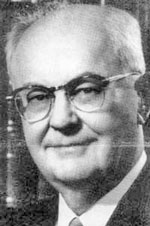 WRIGHT PATMAN (1893-1976)
(image right) WRIGHT PATMAN (1893-1976)
(image right)
Congressman and Chairman of the House Banking and Currency Committee
1963-74. Led the fight in Congress to stop the manipulators of the
Federal Reserve System from 1937 to his death in 1976.
CONGRESSMAN ARSENE PUJO
Served in Congress 1903-1913. Democrat from Louisiana. Chairman of
House Banking and Currency Committee. Chairman of "Pujo Hearings"
Subcommittee, 1912.
SIR GORDON RICHARDSON (1915- )
Head of the Bank of England since 1973. Chairman J. Henry Schroder
Wagg, London, 1962-72; director of J. Henry Schroder Banking
Corporation, New York; Schroder Banking Corporation, New York;
Lloyd’s Bank, London; Rolls Royce.
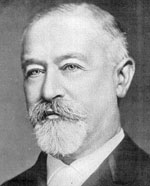 JACOB SCHIFF (1847-1920)
(image right) JACOB SCHIFF (1847-1920)
(image right)
Born in Rothschild house in Frankfurt, Germany. Emigrated to United
States, married Therese Loeb, daughter of Solomon Loeb, founder of
Kuhn, Loeb and Co. Schiff became senior partner of Kuhn, Loeb and
Co., and as representative of Rothschild interests gained control of
most of railway mileage in United States.
BARON KURT VON SCHRODER (1889- )
Adolph Hitler’s personal banker, advanced funds for Hitler’s
accession to power in Germany in 1933; German representative of the
London and New York branches of J. Henry Schroder Banking
Corporation; SS Senior Group Leader; director of all German
subsidiaries of I.T.T; Himmler’s Circle of Friends; advisor to board
of directors, Deutsche Reichsbank (German central bank).
ANTHONY MORTON SOLOMON (1919- )
Educated at Harvard, economist Office of Price Administration,
1941-42; financial mission to Iran, 1942-46; Agency for
international Development South America, 1965-69; president
international Investment Corporation for Yugoslavia 1969-72; advisor
to Chairman, Ways and Means Committee, House of Representatives,
1972-73; Undersecretary Monetary Affairs, U.S. Treasury, 1977-80;
president Federal Reserve Bank of New York, 1980-
SAMUEL UNTERMYER (1858-1940)
A partner of the law firm of Guggenheimer and Untermyer of New York,
who conducted the "Pujo Hearings" of the House Banking and Currency
Committee in 1912. Counsel for Rogers and Rockefeller in many large
suits against F. Augustus Heinze, Thomas W Lawson and others. Earned
a single fee of $775,000 for handling merger of Utah Copper Company.
Reported in The New York Times May 26, 1924 as urging immediate
recognition of Soviet Russia at Carnegie Hall meeting. Untermyer’s
prestige and power is illustrated by the fact that this front page
obituary in The New York Times covered six columns. His listing in
Who’s Who was the longest for thirteen years.
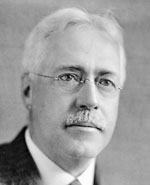 FRANK VANDERLIP (1864-1937)
(image right) FRANK VANDERLIP (1864-1937)
(image right)
Assistant Secretary of Treasury 1897-1901; won prestige for
financing Spanish American War by floating $200,000,000 in bonds
during his incumbency for what is known as "National City Bank’s
War" President of National City Bank 1909-19. One of the original
Jekyll Island group who wrote Federal Reserve Act in November, 1910.
No mention of this important fact is made in extensive obituary in
The New York Times, June 30, 1937.
 GEORGE SYLVESTER VIERECK (1884-1962)
(image right) GEORGE SYLVESTER VIERECK (1884-1962)
(image right)
Author of the definitive study
The Strangest Friendship in History,
Woodrow Wilson and Col. House, Liveright, 1932. A leading poet of
the early 1900’s, reviewed on the front page of The New York Times
Book Review, and known as the leading German-American citizen of the
United States.
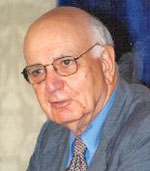 PAUL VOLCKER (1927- )
(image right) PAUL VOLCKER (1927- )
(image right)
Chairman of the Federal Reserve Board of Governors since 1979,
appointed by President Carter, reappointed by President Reagan for
another four year term beginning August 6, 1983. Educated at
Princeton, Harvard and London School of Economics; employed by
Federal Reserve Bank of New York, 1952-57; Chase Manhattan Bank,
1957-61; Treasury Department, 1961-74; president Federal Reserve
Bank of New York, 1975-79.
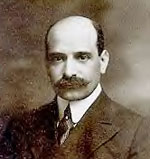 PAUL WARBURG (1868-1932)
(image right) PAUL WARBURG (1868-1932)
(image right)
Conceded to be the actual author of our central bank plan,
the
Federal Reserve System, by knowledgeable authorities. Emigrated to
the United States from Germany 1904; partner, Kuhn Loeb and Company
bankers, New York; naturalized 1911. Member of the original Federal
Reserve Board of Governors, 1914-1918; president Federal Advisory
Council, 1918-1928. Brother of Max Warburg, who was head of German
Secret Service during World War I and who represented Germany at the
Peace Conference, 1918-1919, while Paul was chairman of the Federal
Reserve System.
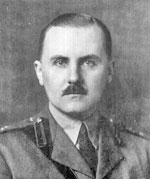 SIR WILLIAM WISEMAN (1885-1962)
(image right) SIR WILLIAM WISEMAN (1885-1962)
(image right)
Partner of Kuhn, Loeb and Company;
head of British Secret Service
during World War I. Worked closely with Col. House dominating the
United States and England.
Go Back
BIBLIOGRAPHY
Newspapers:
Periodicals:
-
Barron’s Weekly 1921-1983
-
Business Week 1929-1983
-
Forbes Magazine 1917-1983
-
Fortune 1930-1983
-
Harper’s 1850-1983
-
National Review 1955-1983
-
Newsweek 1933-1983
-
The Nation 1865-1983
-
The New Republic 1914-1983
-
Time 1923-1983
Books:
-
Current Biography 1940-1983 H.W. Wilson Co., N.Y.
-
Dictionary of National Biography, Scribners, N.Y. 1934-1965
-
Directory of Directors, London 1896-1983
-
Directory of Directors In The City of New York 1898-1918
-
The Concise Dictionary of National Biography, 1903-1979, Oxford
University
Press
-
Congressional Record 1910-1983
-
International Index to Periodicals 1920-1965, H.W. Wilson Co., N.Y.
-
Poole’s Index to Periodical Literature 1802-1906, Wm. T Poole,
Chicago
Readers Guide to Periodicals 1900-1983
-
Rand McNally’s Bankers Guide 1904-1928
-
Moody’s Banking and Finance 1928-1968
-
Who’s Who in America 1890-1983, A.N. Marquis Co.
-
Who’s Who, Great Britain 1921-1983
-
Who Was Who In America 1607-1906, A.N. Marquis Co.
-
Who’s Who in the World 1972-1983, A.N. Marquis Co.
-
Who’s Who in Finance and Industry 1936-1969, A.N. Marquis Co.
-
Standard and Poor’s Register of Directors 1928-1983
-
Senate Committee Hearings on Federal Reserve Act, 1913
-
House Committee Hearings on Federal Reserve Act, 1913
-
House Committee Hearings on the Money Trust (Pujo Committee) 1913
-
House Investigation of Federal Reserve System, 1928
-
Senate Investigation of Fitness of Eugene Meyer to be a Governor of
the Federal
Reserve Board, 1930
-
Senate Hearings on Thomas B. McCabe to be a Governor of the Federal
Reserve
System, 1948
-
House Committee Hearings on Extension of Public Debt, 1945
-
Federal Reserve Directors: A Study of Corporate and Banking
Influence.
-
Staff Report, Committee on Banking, Currency and Housing, House of
Representatives, 94th Congress, 2d Session, August, 1976.
-
The Federal Reserve System, Purposes and Functions, Board of
Governors, 1963
-
A History of Monetary Crimes, Alexander Del Mar, the Del Mar
Society, 1899
-
Fiat Money Inflation in France, Andrew Dickson White, Foundation for
Economic Education, N.Y. 1959
-
The War on Gold, Antony C. Sutton, 76 Press, California, 1977
-
Wall Street and the Rise of Hitler, Antony C. Sutton, 76 Press,
California, 1976
-
Collected Speeches of Louis T McFadden, Congressional Record
-
The Truth About Rockefeller, E.M. Josephson, Chedney Press, N.Y.
1964
-
The Strange Death of Franklin D. Roosevelt, E.M. Josephson, Chedney
Press,
N.Y. 1948
-
Behind the Throne, Paul Emden, Hoddard Stoughton, London, 1934
-
The Money Power of Europe, Paul Emden, Hoddard Stoughton, London
-
The Robber Barons, Mathew Josephson, Harcourt Brace, N.Y. 1934
-
The Rothschilds, Frederic Morton, Curtis Publishing Co., 1961
-
The Magnificent Rothschilds, Cecil Roth, Robert Hale Co., 1939
-
Pawns In The Game, William Guy Carr, (privately printed), 1956
-
Tearing Away the Veils, Francois Coty, Paris, 1940
-
Writers on English Monetary History, 1626-1730, London, 1896
-
The Federal Reserve System After Fifty Years, Committee on Banking
and
Currency, Jan., Feb. 1964
-
The Bankers’ Conspiracy, Arthur Kitson, 1933
-
Laws Of The United States Relating to Currency, Finance and Banking
From
1789 to 1891, Charles F. Dunbar, Ginn & Co., Boston, 1893
-
Monetary Policy of Plenty Instead of Scarcity, Committee on Banking
and
Currency, 1937-1938
-
The Strangest Friendship In History, Woodrow Wilson and Col. House,
George
Sylvester Viereck, Liveright, N.Y. 1932
-
Federal Reserve Policy Making, G.L. Bach, Knapf, N.Y. 1950
-
Rulers of America, A Study of Finance Capital, Anna Rockester,
International
Publishers, N.Y. 1936
-
Banking in the United States Before the Civil War, National Monetary
Commission, 1911
-
National Banking System, National Monetary Commission, 1911
-
The Federal Reserve System, Paul Warburg, Macmillan, N.Y. 1930
-
Roosevelt, Wilson and the Federal Reserve Law, Col. Elisha Garrison,
Christopher Publishing House, Boston, 1931
-
Men Who Run America, Arthur D. Howden Smith, Bobbs Merrill, N.Y.,
1935
-
Financial Giants of America, George E Redmond, Stratford, Boston,
1922
-
The Great Soviet Encyclopaedia, Macmillan, London, 1973
-
Encyclopaedia Britannica, 1979
-
Encyclopaedia Americana, 1982
-
Dope, Inc., Goldman, Steinberg et at, New Benjamin Franklin House
Publishing
Company, N.Y. 1978
-
Banking and Currency and the Money Trust, Charles A. Lindbergh, Sr.
1913
-
The Strange Career of Mr. Hoover Under Two Flags, John Hamill,
William Faro,
N.Y. 1931
-
The Federal Reserve System, H. Parker Willis, Ronald Co., 1923
-
A.B.C. of the Federal Reserve System, E.W. Kemmerer, Princeton
Univ., 1919
-
Adventures in Constructive Finance, Carter Glass, Doubleday, N.Y.
1927
-
Banking Reform in the United States, Paul Warburg, Columbia Univ.,
1914
-
U.S. Money vs. Corporation Currency, Alfred Crozier, Cleveland, 1912
-
Philip Dru -
Administrator, E.M. House, B.W. Huebsch, N.Y. 1912
-
The Intimate Papers of Col. House, edited by Charles Seymour, 4 v.
1926-1928,
Houghton Mifflin Co.
-
The Great Conspiracy of the House of Morgan, H.W. Loucks, 1916
-
Capital City, McRae and Cairncross, Eyre Methuen, London, 1963
-
Aggression, Otto Lehmann-Russbeldt, Hutchinson, London, 1934
-
The Empire of High Finance, Victor Perlo, International Pub., 1957
-
Memoirs of Max Warburg, Berlin, 1936
-
Letters and Friendships of Sir Cecil Spring-Rice
Tragedy and Hope, Carroll Quigley, Macmillan, N.Y.
-
The Politics of Money, Brian Johnson, McGraw Hill, N.Y. 1970
-
A Primer on Money, House Banking and Currency Committee, 1964
-
Pierpont Morgan and Friends, The Anatomy of A Myth, George Wheeler,
Prentice Hall, N.J., 1973
-
Pierpont Morgan, Herbert Satterleee, Macmillan, N.Y., 1940
-
Morgan the Magnificent, John K. Winkler, Vanguard, N.Y., 1930
-
Wilson, Arthur Link (5 vol.) Princeton University Press, Princeton,
N.J.
-
Historical Beginning… The Federal Reserve, Roger T Johnson, Federal
Reserve
Bank of Boston, 1977 (7 printings, 1977-1982, totaling 92,000
copies.) [It
is noteworthy that this 64 page booklet makes no mention of Jekyll
Island,
Paul Warburg’s authorship, or source of promotion funds which
resulted
in enactment of the Federal Reserve Act on December 23, 1913.]
-
The Federal Reserve and Our Manipulated Dollar, Martin A. Larson,
Devin Adair
Co., Old Greenwich, Conn., 1975
-
Chain Banking, Stockholder and Loan Links of 200 Largest Member
Banks,
House Banking and Currency Committee, Jan. 3, 1963
-
International Banking, Staff Report, Committee on Banking Currency
and
Housing, May 1976
-
Audit of the Federal Reserve System, Hearings Before the House
Banking and
Currency Committee, 1975.
Go Back
INDEX
|
A
Abbot, Lawrence--22
Adams, John Quincy--48
Aldrich, Nelson--1, 2, 3,
6, 7, 8, 9, 10, 11, 19, 21, 22, 30, 33,
36
Aldrich-Vreeland Emergency Currency Bill--12, 19, 20, 22
Allen, W.H.--33
American Acceptance
Council--128
American Bankers
Association--13, 127
American Relief
Administration-- 74, 78
Andrew, A. Piatt--1
Astor, John Jacob--64, 65
Auchincloss, Gordon--107
B
Bagdikian, Ben H.--61
Baker, George F.--16, 42,
43, 47, 66, 67
Baker, George F., Jr.--66
Bank of England--32, 42,
51, 52, 58, 59, 68, 69, 80, 123, 129, 131, 133, 142, 146, 180
Bank of France--32, 135
Banking Act of 1935--29,
159
Barnes, Julius--73, 74
Barron, Clarence W.--30
Baruch, Bernard--17, 26,
28, 74, 86, 89, 90, 94, 99, 109, 111, 12, 139, 147, 151
Bechtel Corporation--77, 79
Belgian Relief
Commission--69, 70, 72, 73, 74, 78, 83
Belmont, August--53
Biddle, Nicholas--6, 50
Bilderbergers--54, 172
Bleichroder, Samuel--59
Blumenthal, George--14
|
Brandeis, Justice
Louis--87, 109
Bristow, Senator--38
Brookhart, Senator--117
Brown, Alexander--49
Alex Brown & Son--49
Brown Brothers Bankers--22,
49, 131
Brown Brothers
Harriman--22, 48, 49, 61, 68, 79, 131, 171, 172, 175
Brown Shipley &
Company--49, 68
Bryan, William
Jennings--26, 29, 82, 83, 118
Bull Moose Party--18
Bush, George--49
Bush, Prescott--49
Byrnes, James--17
C
Canaris, Admiral--62
Carr, William Guy--53, 55
Carter, Jimmy--171, 172,
173
Cassel, Ernest--59
Cavell, Edith--72, 73
Central Bank--5
Chamberlain, Neville--78
Churchill, Winston--78, 123
Clark, Champ--29
Clay, John--182
Clews, Henry--50
Cooper, Kent--60
Council on Foreign
Relations--35, 54, 81, 172
Crissinger, D.R.--141
Cromwell, Oliver--58
Crozier, Alfred--20
D
Dabney, Charles H.--50, 51
Davison, Daniel--63
|
|
Davison, Henry P.--1, 2, 4,
33, 43, 44, 66, 103
Debs, Eugene--105
Delano, F.A.--36, 114
Delano, Warren--36
Dodge, Cleveland H.--103,
105
Drexel, Anthony--53
Drexel & Company--48,
54
Dulles, Allen--62, 75, 76
Dulles, John Foster--75, 81
Duncan Sherman Company--50
E
Eccles, Marriner--122, 126,
159, 162, 163, 164, 167, 168, 169
Eisenhower, Dwight D.--75,
81
Ellery, William--48
Emden, Paul--36, 60
F
Federal Advisory
Council--6, 19, 40, 41, 42, 43, 44, 45, 113, 116, 117, 119, 128, 129, 144
Federal Reserve Act--7, 9,
15, 16, 18, 19, 21, 23, 26, 27, 28, 29, 30, 31, 33, 34, 35, 40, 45, 64, 82, 125, 126, 139, 162, 168, 171
Federal Reserve Banks--6,
8, 34, 35, 40, 41, 44, 83
Federal Reserve Board of Governors--6, 14, 19, 23, 29, 31, 32, 34, 35, 36, 37, 38, 39, 41, 42, 44, 45, 64, 78, 86, 87, 95, 112, 119, 124, 125, 126, 128, 129, 133, 139, 140, 143, 144, 145, 146, 149, 154, 157, 159, 162, 163, 165, 169, 171, 172, 180
Federal Reserve System--5,
6, 7, 8, 19, 21, 29, 30, 32, 35, 40, 41, 42, 43, 63, 67, 82, 84, 113, 114, 115, 118, 119, 120, 121, 22, 127, 128, 132, 134, 139,
140, 141, 143, 146, 158, 162, 163, 164, 165, 166, 168, 169, 170, 176, 180
Ferdinand, Archduke--69
First Name Club--3, 8, 33
|
First National Bank of
N.Y.--1, 34, 41, 42, 44, 47, 64, 66, 67
Forbes, B.C.--2, 7
Forbes, Malcom--2
Forgan, James B.--41, 42
Frame, Andrew--13, 14
Francqui, Emile--69, 70,
71, 72
G
Garfield, James A.--20
Garrison, Col. Ely--22, 23,
120
Gates, Thomas S.--48
Glass, Carter--13, 14, 19,
21, 22, 29, 30, 34, 40, 45, 114, 116, 117, 138, 160
Glass-Steagall Banking
Act--159
Goldenweiser, Emanuel--118,
136, 146, 148
Graham, Katherine--97
Gray, Prentiss--73, 78
Guggenheim--90
H
Hamill, John--69, 70
Hamilton, Alexander--5
Hamlin, Charles S.--36,
129, 138, 147
Hanauer, Jerome J.--87, 95,
99
Harding, W.P.G.--36, 103,
121, 157
Harriman, E.H.--67, 90
Harriman, Mary--67
Harrison, George L.--132
Herrick, Myron T.--117
Hess, Rudolf--78
Hill, James J.--47
Hiss, Alger--24, 83
Hiss, Donald--24
Hitler, Adolf--75, 76, 77,
78, 79, 81
Hoover, Herbert H.--69, 70,
71, 72, 73, 74, 78, 139, 149, 150, 151, 158
House, Col. Edward
Mandel--21, 23, 24, 25, 26, 27, 29, 30, 31, 36, 79, 88, 107, 109, 111
Hull, Cordell--84
|
|
I
International Acceptance
Bank-- 128, 144
Insull, Samuel--148
J
Jackson, Andrew--5, 50
Jaffray, C.T.--43
James, F. Cyril--42
Jefferson, Thomas--5, 7, 35
Jekyll Island--2, 3, 4, 5,
8, 9, 10, 11, 12, 20, 29, 33, 41, 44, 171
Jekyll Island Club--3
Jones, Thomas D.--36, 38,
39
Josephson, Matthew--60, 67
Juillard, A.D.--67
K
Kahn, Otto--19, 38, 66, 107
Kains, Archibald--43
Kaiping Coal Mines--70
Kemmerer, E.W.--85, 124
Kreuger, Ivar--71, 148, 149
Kuhn, Loeb Company--1, 17,
18, 21, 33, 35, 36, 37, 38, 39, 41, 44, 47, 48, 61, 66, 67, 71, 72, 74, 81, 83, 85, 86, 87, 88, 89, 99, 101, 103, 119, 127, 128, 146, 174, 175
L
LaFollette, Senator Robert
M.--16, 17, 18
Lamont, T.W.--2, 109, 111,
128
Laughlin, J. Lawrence--10,
11, 33
Lazard Freres--14, 34, 53,
61, 68, 74, 76, 94, 99, 152
League of Nations--136,
143, 170
Leguia, Juan--155
Lehman, Herbert--101
Lehman Brothers--35, 66,
101, 175
Lincoln, Abraham--20, 65
Lindbergh, Charles A.,
Sr.--11, 16, 17, 18, 28, 112
Loeb, Solomon--33
Lovett, Robert--48
Lundberg, Ferdinand--32
|
Manati Sugar
Corporation--73, 80, 81
Marbury, Bessie--155
Markoe, James --131
Marshall, Louis--29
Martin, William
McChesney--163
McAdoo, William--19, 21,
26, 29, 322, 39, 99, 101, 114
McFadden, Louis--71, 72,
74, 75, 95, 127, 128, 133, 134, 135, 136, 137, 150, 151, 152, 153, 154
McIntosh, J.W.--103
Mellon, Andrew--142, 147,
150
Meyer, Eugene--14, 17, 34,
61, 72, 74, 75, 94, 95, 99, 118, 122, 150, 151, 152, 153, 159, 171
Miller, Adolph C.--36, 129,
133, 134, 135, 136, 157, 166
Minsky--67
Money Trust--11, 12, 16
Montague, Samuel &
Co.--38, 68
Moody, John--47, 52
Morgan Grenfell Company--63,
68
Morgan Harjes Company--54
Morgan, J.P.--1, 2, 3, 10,
16, 17, 18, 26, 32, 35, 41, 42, 43, 44, 47, 48, 49, 50, 51, 52, 53, 54, 66, 67, 75, 83, 101, 129, 146, 150, 160, 174, 176
Morgan, J.P. Company--1,
33, 35, 41, 47, 48, 53, 66, 123, 148, 174
Morgan, Joseph--51
Morgan, Junius S.--50, 51,
53, 65, 66
Morton, Frederic--56
Morton, Levi P.--67
Mountbatten, Philip--60
N
Napoleon de Bonaparte--57
Nation, The--12, 16, 19,
30, 37
National Bank Act of
1864--125
National Citizen’s
League--10, 11
National City Bank--21, 33,
34, 41, 64, 65, 66, 112, 126, 127
National Monetary
Commission--1,4, 5, 10, 11, 12, 13, 14, 15, 33,124, 125
|
|
National Recovery Act--159,
168
National Reserve Plan--7
New York Times--27, 28, 29,
33, 35, 37, 40, 44, 61, 71, 74, 75, 80, 112, 119, 126, 144, 166, 171
Norman, Lord Montagu--49,
76, 77, 123, 129, 131, 132, 133, 142, 150
Norten, Charles D.--1, 33
O
O’Gorman, Senator--14, 38
Owen, Robert L.--17, 19,
29, 38, 39, 40, 41, 116, 119, 138, 157, 161
Owen-Glass Bill--21
P
Page, Walter Hines--83
Panic of 1837--5, 50, 51,
65
Panic of 1857--51, 52, 65
Panic of 1907--1, 2, 5, 10,
12, 21
Paterson, William--58, 59
Patman, Wright--34, 164,
165, 167
Peabody, George--49, 50,
51, 52, 54, 65, 171
Peabody, Riggs &
Co.--49
Pegler, Westbrook--23
Pemberton, Robert Leigh--80
Pound, Ezra--58
Pressman, Lee--24
Princeps, Gavrel--69
Pujo, Arsene--16
Pujo Committee--16, 17, 18,
149
Pyne, Moses Taylor--66
Pyne, Percy--65, 66
Q
Quigley, Dr. Carrol--53,
131
R
Reagan, Ronald--77, 79, 80,
173, 175
Reichsbank--12, 132
Rhodes, Cecil--53
|
Richardson, Sir Gordon--80
Rickard, Edgar--74
Rionda, M.E.--73
Rockefeller, David--171,
172, 176
Rockefeller, John D.--47,
65
Rockefeller, William--47,
65
Rockefeller, William, Jr.--65
Roosa, Robert--54, 171, 172
Roosevelt, Franklin
Delano--23, 24, 30, 31, 84, 129, 137, 139, 145, 151, 155, 156, 158, 159, 162, 169, 170
Roosevelt, Theodore--1, 18,
19, 22, 38, 82
Rosebury, Lord--53
Rothschild, Baron
Alfred--23, 60
Rothschild, House of--17,
47, 48, 50, 52, 53, 54, 60
Rothschild, James--5, 50,
57, 59, 61, 66, 109
Rothschild, Leopold--60
Rothschild, Mayer
Amschel--55, 56
Rothschild, N.M.--48, 49,
51, 53, 57, 58, 59, 68, 171
Round Table--53, 54, 62
Rowe, W.S.--43, 70
Rue, Levi L.--42
Ryan, John Barry--66
Ryan, Thomas Fortune--66
Ryan, Virginia Fortune--66
S
Schiff, Jacob--17, 19, 26,
29, 42, 47, 66, 67, 86, 87, 90, 149
Schiff, John--66
Schiff, Ludwig--87
Schiff, Philip--87
Schoellkopf Family--34
Scholey, David--182
Schroder, Baron Bruno
Von--69, 76
Schroder, Baron Rudolph
Von--76
Schroder, J. Henry Co.--48,
67, 68, 69, 71, 73, 74, 75, 76, 77, 78, 79, 80, 81, 175, 176, 179, 180
Schultz, George--79
Seligman, E.R.A.--9
Seligman, J. & W.--9,
17, 71, 109, 114, 155
|
|
Seymour, Charles--31
Shaw, Leslie--14
Shelton--1, 2
Simpson, John Lowery--78
Smith, Rixey--29, 112
Sontag, Susan--61
Sprague, O.M.W.--11, 114,
161
Spring-Rice, Sir Cecil--89
St. George, George F.--66
St. George, Katherine--66
Sterling, John W.--66
Stillman, Don Carlos--65
Stillman, James--8, 47, 65,
66
Stimson, Henry L.--161
Stone, Senator--21
Strauss, Albert--112, 114,
122, 140, 141, 157
Strong, Benjamin--1, 3, 32,
33, 44,118, 123, 129, 131, 132, 133, 137, 138
Sugar Equalization
Board--74
Swinney, E.F.--43
T
Taft, William Howard--18,
19, 38, 82
Taylor, Congressman--14
Taylor, H.A.C.--66
Taylor, Moses--64, 65, 66
Tavistock Institute--80,
184, 185
Thalmman, Ladenburg--17
Tiarks, Frank Cyril--69,
73, 76, 77
Tientsin Railroad--72
Tobacco Trust--89
Trilateral Commission--35,
54, 172
Tugwell, Rexford Guy--162
U
Untermeyer, Samuel--17, 18
U.S. Food
Administration--73, 74, 78, 87
|
V
Vanderlip, Frank--1, 2, 3,
8, 9, 19,33, 44, 161
Vickers Sons &
Maxim--60
Viereck, George--23, 25, 27
Volcker, Paul--34, 171,
172, 173, 183
Vreeland, Edward--12
W
War Finance
Corporation--24, 86, 94, 95, 97, 99, 151, 153
War Industries Board--74,
86, 90,151
Warburg, Felix--38, 86, 87,
128, 129
Warburg, James Paul--128,
129, 156, 161
Warburg, M.M. Company--12,
17, 34, 54
Warburg, Max--84, 86, 87,
88, 111
Warburg, Paul Moritz--1, 2,
3, 4, 5, 6, 7, 8, 9, 12, 14, 19, 21, 22, 23, 24, 26, 28, 29, 30, 33, 34, 36, 37, 38, 40, 41, 42, 43, 44, 48, 66, 71, 74, 84, 86, 87, 88, 89, 99, 111, 112, 115, 117, 119, 120, 122, 126, 127, 128, 138, 144, 148, 156, 157, 164
Weinberger, Caspar--79
Wetmore, Frank O.--42
White, Harry Dexter--24
Williams, John Skelton--21,
32, 39,101, 103, 140
Willis, H. Parker--132,
140, 142
Wilson, Woodrow--10, 17,
18, 19, 22, 23, 24, 25, 26, 28, 29, 30, 32, 36, 38, 39, 41, 82, 83, 84, 85, 86, 87, 88, 89, 90, 99, 101, 103, 105, 107, 109, 111, 112, 117, 137, 139, 140, 141, 156
Wing, Daniel S.--43
Wiseman, Sir William--73,
88, 105, 107, 111
Z
Zabriskie, G.A.--73, 74
|
Go Back
Questions and Answers
While lecturing in many countries, and appearing on radio and
television programs as a guest, the author is frequently asked
questions about the Federal Reserve System. The most frequently
asked questions and the answers are as follows:
Q: What is the Federal Reserve System?
A: The Federal Reserve System is not Federal; it
has no reserves;
and it is not a system, but rather, a criminal syndicate. It is the
product of criminal syndicalist activity of an international
consortium of dynastic families comprising what the author terms
"The
World Order" (see "THE WORLD ORDER" and "THE CURSE OF CANAAN",
both by Eustace Mullins). The Federal Reserve system is a central
bank operating in the United States. Although the student will find
no such definition of a central bank in the textbooks of any
university, the author has defined a central bank as follows:
-
It is
the dominant financial power of the country which harbors it.
-
It is
entirely private-owned, although it seeks to give the appearance of
a governmental institution.
-
It has the right to print and issue
money, the traditional prerogative of monarchs.
-
It is set up to
provide financing for wars.
-
It functions as a money monopoly having
total power over all the money and credit of the people.
Q: When Congress passed the Federal Reserve Act on December 23,
1913, did the Congressmen know that they were creating a central
bank?
A: The members of the 63rd Congress had no knowledge of a central
bank or of its monopolistic operations. Many of those who voted for
the bill were duped; others were bribed; others were intimidated.
The preface to the Federal Reserve Act reads,
"An Act to provide for
the establishment of Federal reserve banks, to furnish an elastic
currency, to afford means of rediscounting commercial papers, to
establish a more effective supervision of banking in the United
States, and for other purposes."
The unspecified "other purposes"
were to give international conspirators a monopoly of all the money
and credit of the people of the United States; to finance World War
I through this new central bank, to place American workers at the
mercy of the Federal Reserve system’s collection agency, the
Internal Revenue Service, and to allow the monopolists to seize the
assets of their competitors and put them out of business.
Q: Is the Federal Reserve system a government agency?
A: Even the present chairman of the House Banking Committee claims
that the Federal Reserve is a government agency, and that it is not
privately owned. The fact is that the government has never owned a
single share of Federal Reserve Bank stock. This charade stems from
the fact that the President of the United States appoints the
Governors of the Federal Reserve Board, who are then confirmed by
the Senate. The secret author of the Act, banker Paul Warburg, a
representative of the Rothschild bank, coined the name "Federal"
from thin air for the Act, which he wrote to achieve two of his pet
aspirations, an "elastic currency", read (rubber check), and to
facilitate trading in acceptances, international trade credits.
Warburg was founder and president of the International Acceptance
Corporation, and made billions in profits by trading in this
commercial paper. Sec. 7 of the Federal Reserve Act provides
"Federal reserve banks, including the capital and surplus therein,
and income derived therefrom, shall be exempt from Federal, state
and local taxation, except taxes on real estate."
Government
buildings do not pay real estate tax.
Q: Are our dollar bills, which carry the label "Federal Reserve
notes" government money?
A: Federal Reserve notes are actually
promissory notes, promises to
pay, rather than what we traditionally consider money. They are
interest bearing notes issued against interest bearing government
bonds, paper issued with nothing but paper backing, which is known
as fiat money, because it has only the fiat of the issuer to
guarantee these notes. The Federal Reserve Act authorizes the
issuance of these notes,
"for the purposes of making advances to
Federal reserve banks... The said notes shall be obligations of the
United States. They shall be redeemed in gold on demand at the
Treasury Department of the United States in the District of
Columbia."
Tourists visiting the Bureau of Printing and Engraving on
the Mall in Washington, D.C. view the printing of Federal Reserve
notes at this governmental agency on contract from the Federal
Reserve System for the nominal sum of .00260 each in units of 1,000,
at the same price regardless of the denomination. These notes,
printed for a private bank, then become liabilities and obligations
of the United States government and are added to our present $4
trillion debt. The government had no debt when the Federal Reserve
Act was passed in 1913.
Q: Who owns the stock of the Federal Reserve Banks?
A: The dynastic families of the ruling
World Order,
internationalists who are loyal to no race, religion, or nation.
They are families such as the
Rothschilds, the Warburgs, the
Schiffs, the
Rockefellers, the Harrimans, the
Morgans and others
known as the elite, or "the big rich".
Q: Can I buy this stock?
A: No. The Federal Reserve Act stipulates that the stock of the
Federal Reserve Banks cannot be bought or sold on any stock
exchange. It is passed on by inheritance as the fortune of the "big
rich". Almost half of the owners of Federal Reserve Bank stock
are
not Americans.
Q: Is the Internal Revenue Service a governmental agency?
A: Although listed as part of the Treasury Department, the
IRS is
actually a private collection agency for the Federal Reserve System.
It originated as the Black Hand in mediaeval Italy, collectors of
debt by force and extortion for the ruling Italian mob families. All
personal income taxes collected by the IRS are required by law to be
deposited in the nearest Federal Reserve Bank, under Sec. 15 of the
Federal Reserve Act,
"The moneys held in the general fund of the
Treasury may be ....deposited in Federal reserve banks, which
banks,
when required by the Secretary of the Treasury, shall act as fiscal
agents of the United States."
Q: Does the Federal Reserve Board control the daily price and
quantity of money?
A: The Federal Reserve Board of Governors, meeting in private as the
Federal Open Market Committee with presidents of the
Federal Reserve
Banks, controls all economic activity throughout the United States
by issuing orders to buy government bonds on the open market,
creating money out of nothing and causing inflationary pressure, or,
conversely, by selling government bonds on the open market and
extinguishing debt, creating deflationary pressure and causing the
stock market to drop.
Q: Can Congress abolish the Federal Reserve System?
A: The last provision of the Federal Reserve Act of 1913, Sec. 30,
states,
"The right to amend, alter or repeal this Act is
expressly
reserved."
This language means that Congress can at any time
move to
abolish the Federal Reserve System, or buy back the stock and make
it part of the Treasury Department, or to altar the System as it
sees fit. It has never done so.
Q: Are there many critics of the Federal Reserve beside yourself?
A: When I began my researches in 1948, the Fed was only thirty-four
years old. It was never mentioned in the press. Today the Fed is
discussed openly in the news section and the financial pages. There
are bills in congress to have the Fed audited by the
Government
Accounting Office. Because of my expose, it is no longer a sacred
cow, although the Big Three candidates for President in 1992, Bush,
Clinton and Perot, joined in a unanimous chorus during the debates
that they were pledged not to touch the Fed.
Q: Have you suffered any personal consequences because of your
expose of the Fed?
A: I was fired from the staff of the
Library of Congress after I
published this expose in 1952, the only person ever discharged from
the staff for political reasons. When I sued, the court refused to
hear the case. The entire German edition of this book was burned in
1955, the only book burned in Europe since the Second World War. I
have endured continuous harassment by government agencies, as
detailed in my books "A WRIT FOR MARTYRS" and "MY LIFE IN CHRIST".
My family also suffered harassment. When I spoke recently in
 Wembley
Arena in London, the press denounced me as "a sinister lunatic". Wembley
Arena in London, the press denounced me as "a sinister lunatic".
Q: Does the press always support the Fed?
A: There have been some encouraging defections in recent months. A
front page story in the Wall Street Journal, Feb. 8, 1993, stated,
"The current Fed structure is difficult to justify in a democracy.
It’s an oddly undemocratic institution. Its organization is so dated
that there is only one Reserve bank west of the Rockies, and two in
Missouri... Having a central bank with a monopoly over the issuance
of the currency in a democratic society is a very difficult
balancing act."
The
United Nations plans to
CONFISCATE your profit..... (click image
right)

Go Back
|
 NELSON ALDRICH (1841-1915)
(image right)
NELSON ALDRICH (1841-1915)
(image right) WILLIAM JENNINGS BRYAN (1860-1925)
(image right)
WILLIAM JENNINGS BRYAN (1860-1925)
(image right) ALFRED OWEN CROZIER (1863-1939)
(image right)
ALFRED OWEN CROZIER (1863-1939)
(image right) CLARENCE DILLON (1882-1979)
(image right)
CLARENCE DILLON (1882-1979)
(image right) ALAN GREENSPAN (1926- )
(image right)
ALAN GREENSPAN (1926- )
(image right) COLONEL EDWARD MANDELL HOUSE (1858-1938)
(image right)
COLONEL EDWARD MANDELL HOUSE (1858-1938)
(image right) ROBERT MARION LAFOLLETTE (1855-1925)
(image right)
ROBERT MARION LAFOLLETTE (1855-1925)
(image right) CHARLES AUGUSTUS LINDBERGH, SR. (1860-1924)
(image right)
CHARLES AUGUSTUS LINDBERGH, SR. (1860-1924)
(image right) JOHN PIERPONT MORGAN (1837-1913)
(image right)
JOHN PIERPONT MORGAN (1837-1913)
(image right) WRIGHT PATMAN (1893-1976)
(image right)
WRIGHT PATMAN (1893-1976)
(image right) JACOB SCHIFF (1847-1920)
(image right)
JACOB SCHIFF (1847-1920)
(image right) FRANK VANDERLIP (1864-1937)
(image right)
FRANK VANDERLIP (1864-1937)
(image right) GEORGE SYLVESTER VIERECK (1884-1962)
(image right)
GEORGE SYLVESTER VIERECK (1884-1962)
(image right) PAUL VOLCKER (1927- )
(image right)
PAUL VOLCKER (1927- )
(image right) PAUL WARBURG (1868-1932)
(image right)
PAUL WARBURG (1868-1932)
(image right) SIR WILLIAM WISEMAN (1885-1962)
(image right)
SIR WILLIAM WISEMAN (1885-1962)
(image right)